Sphinginae subfamily
Sphingini tribe:

| Manduca quinquemaculatus,
the Five-spotted Hawkmoth. The caterpillars are called Tomato Hornworms and each has a black horn at the end of the abdomen.
Larvae feed on potato, tobacco, tomato, and other plants in the
nightshade family (Solanaceae). There is also a very beautiful brown form. See bottom of page.
|
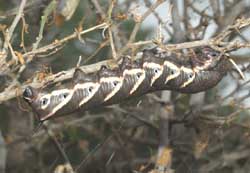
|
Manduca quinquemaculatus
Five-spotted Hawkmoth: Tomato Hornworms: Black horn at end of abdomen. Larvae feed on potato, tobacco, tomato, and other plants in
nightshade family (Solanaceae). Most larvae are green, but there is also very beautiful brown form to left.
|
 |
Manduca sexta, Carolina Sphinx:
Tobacco Hornworms, equipped with red-tipped horn at end of ,
abdomen; true gluttons, feed on tobacco, tomato, occasionally potato, pepper crops, other plants in nightshade family (Solanaceae).
unlikely
|
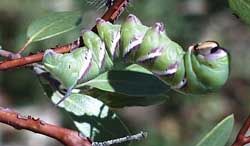 |
Sphinx asellus, Asella sphinx:
Larval hosts are Manzanita and Arctostaphylos of the Ericaceae family. Look for a blue horn and strong purple colouration.
|
 |
Sphinx chersis, Great Ash Sphinx:
Pale bluish green. The head has a pair of yellow lateral bands meeting at the apex. Ash, lilac, privet, cherry, and quaking aspen.
|
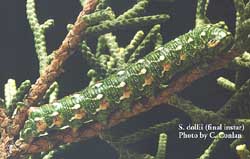 |
Sphinx dollii Doll's sphinx:
Alligator juniper (Juniperus deppeana), other juniper species. It is amazing to me how well the larval
spiracular patches and false feet match the pattern and colour of the juniper bark.
|
 |
Sphinx drupiferarum, Wild Cherry Sphinx.
Larvae hide in the day and feed primarily on cherry, plum, and apple
at night. Larvae have been found on Amelanchier nantuckensis
in Massachusetts and have been reared to pupation in Michigan on
Prunus serotina. Note purple oblique lines.
|
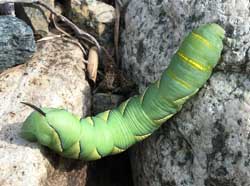 |
Sphinx vashti, Snowberry Sphinx:
Common snowberry (Symphoricarpos albus), coralberry (S. orbiculatus). Two golden
lines of slightly raised bumps, one just behind head, other on thorax.
|
Smerinthini Tribe:
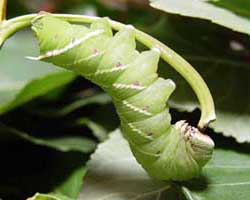 |
Pachysphinx occidentalis, Big Poplar Sphinx:
Larvae feed on cottonwood and poplar (Populus) and willow
(Salix). Larvae are very chunky with little to distinguish them from Pachysphinx modesta.
|
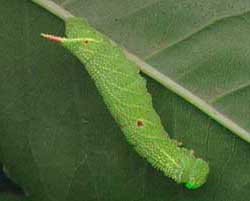 |
Paonias myops, Small-eyed Sphinx:
Wild cherry species are favorites as larval
foodplants, but eggs will also be deposited on birches and other
forest trees. To left, second/third instar larva rests on pin
cherry. "Red heart" marking readily identifies this species.
generally more eastern species; possibly |
 |
Smerinthus cerisyi, Cerisy's Sphinx;
Pale green, granular skin, pale lateral diagonal lines, faint red
spiracular circles, very pale longitudinal lines running from
head to more pronounced anal diagonal line. Green heads bounded dorsally with pale yellow inverted V.
(likely replaced by ophthalmica in Nevada)
|
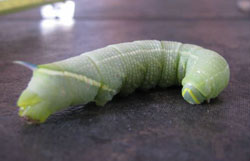 |
Smerinthus ophthalmica
WO:
Ophthalmica larvae resemble cerisyi larvae, both being pale
green, with granular skin, pale lateral diagonal lines, faint red
spiracular circles, and very pale longitudinal lines running from
head to more pronounced anal diagonal line.
Larvae have green heads bounded dorsally with pale yellow
inverted "V". Note blue horn.
|
Macroglossinae subfamily
Dilophonotini tribe:
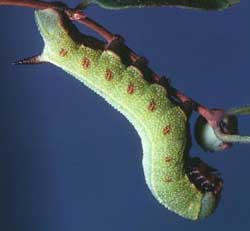 |
Hemaris thetis:
Snowberry (Symphoricarpos),
honeysuckle (Lonicera), Coralberry, viburnums, high bush cranberry, hawthorn (Crataegus).
Horn: black with slightly lighter base. Formerly classified as H. diffinis or H. senta. Those species west of
Continental Divide are now classified as H. thetis.
|
Philampelini tribe:
 |
Eumorpha achemon, Achemon Sphinx:
Larvae feed upon Grape (Vitis), Virginia Creeper
(Parthenocissus quinquefolia), other vines, ivies
(Ampelopsis).
Both light (green) form and darker (tan/brown)
form. Note six "segmented" oblique lines. (doubtful
|
Macroglossini tribe:
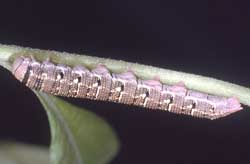 |
Euproserpinus wiesti, Wiest's Primrose Sphinx:
Day flyer over sand washes, prairie blow-outs as single brood from May-June. Prairie primrose (Oenothera latifolia) in evening
primrose family (Onagraceae).
Captive rearing difficult. Larvae need sunshine, heat, humidity.
|
 |
Hyles lineata, White-lined Sphinx:
Highly varied. Willow weed (Epilobium), four o'clock (Mirabilis),
apple (Malus), evening primrose (Oenothera), elm
(Ulmus), grape (Vitis), tomato (Lycopersicon),
purslane (Portulaca), Fuschia. Red/black swellings split by dorso-lateral lines. |
|
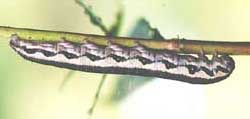 |
Proserpinus clarkiae, Clark's Sphinx.
Larvae feed on elegant fairyfan (Clarkia unguiculata) in the evening primrose family (Onagraceae). |
|



















